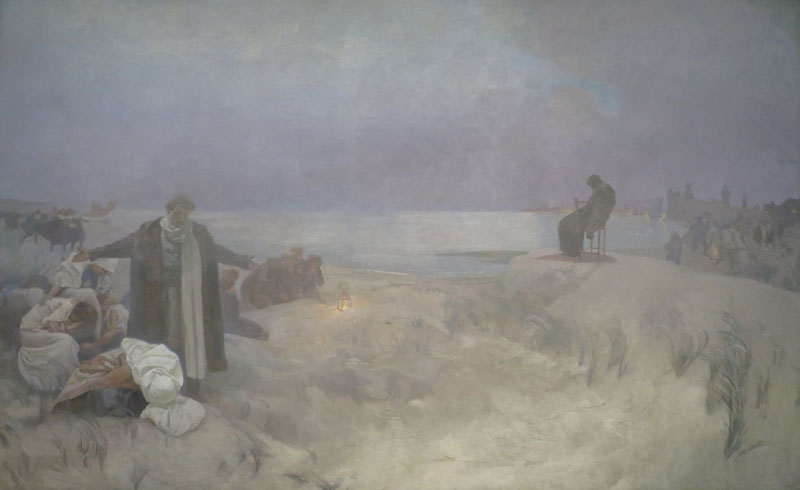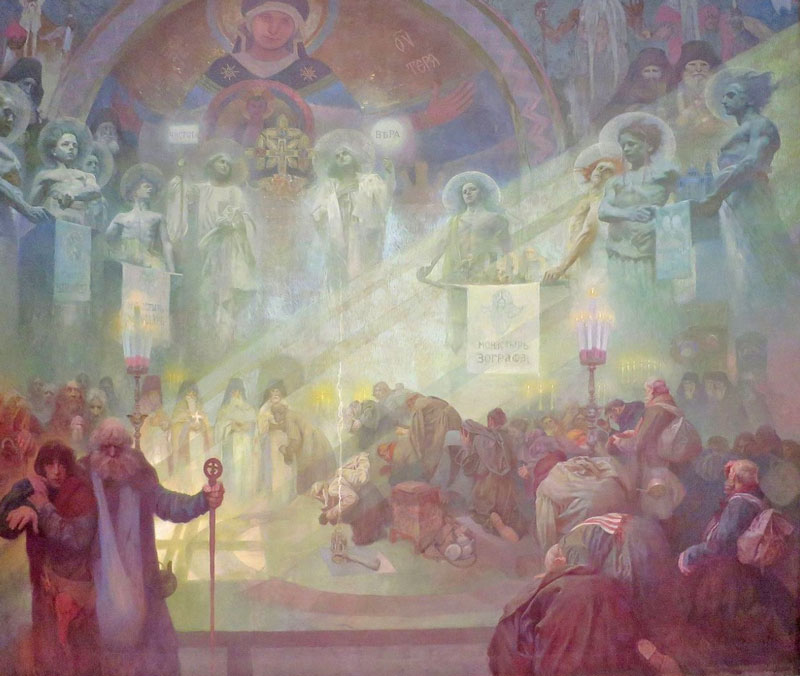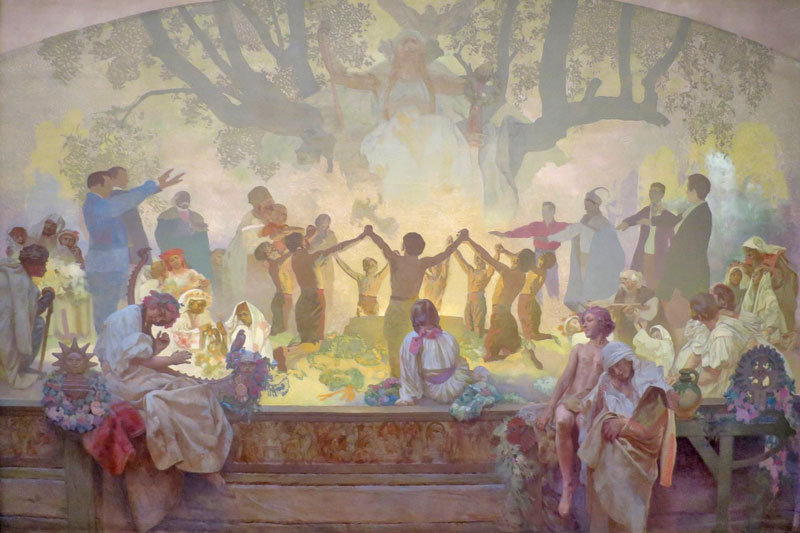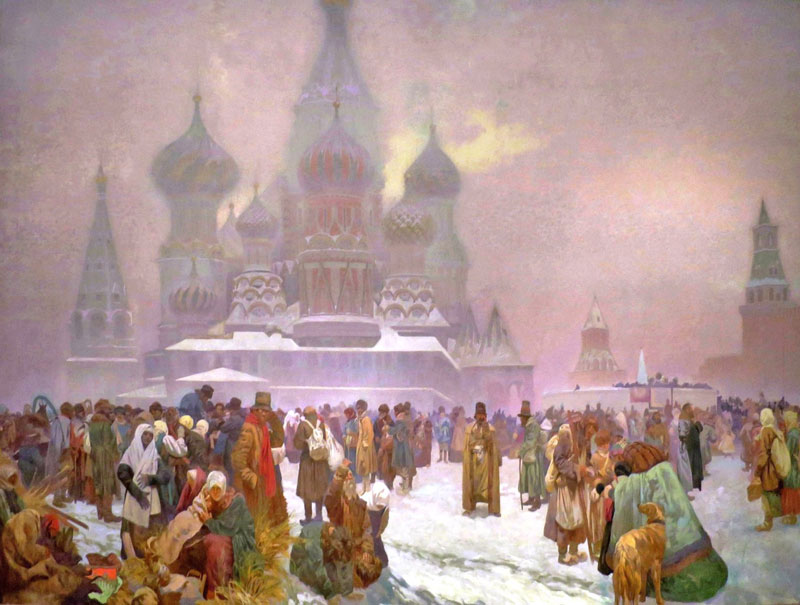Slav Epic Part Five – Paintings 16 to 20
This post explores the detail on paintings numbered 16 to 20 in the Slav Epic with interpretation, what to look for and historic context etc. If you want first to learn what leads up to the creation of the Slav Epic, who painted it, when and where it was painted, who owns it and where it is right now then check Slav Epic Part One.
Slav Epic Painting No.16: Jan Amos Komenský, Flame of Hope (1918)

This painting is set in 1670 but to interpret it we have to go back 50 years. During the Thirty Years War in 1620 the Catholics took control of Prague and shortly afterwards started a program of forced Catholicism. Slavic intellectuals like Komensky who were leaders in the Church of Brethren were given a choice, exile or death.
So Komensky has to first leave Prague then from 1628 he spends time in three or four European countries before finally he seeks refuge in the Dutch coastal town of Naarden where he spent the last 14 years of his life. The painting is almost completely without colour or light with the maximum expression of sadness and despair. Mucha depicts the death of Jan Amos Komensky slumped in a chair on the sea front aged 78 but his life’s work remains and the burning candle signifies that he will inspire future generations of Slavs hence the subtitle “flame of hope”.
Slav Epic Painting No.17: The Holy Mount Athos, Vatican Orthodox (1926)

Personally, it’s my favourite in the series. Probably the two biggest external influences on Mucha were the First World War and his visit to the Mount Athos Greek Orthodox monastery in 1924. Mount Athos would have been extremely important to Southern Slavs (Balkans) and most holy site in the Eastern Orthodox faith. Mucha goes away from specific Slavic references in most of the painting and chooses to accentuate the Orthodox religion which of course is the basis of Christianity in Czech today and the reason for it’s inclusion in the series.
We go back to the levitating figures that we haven’t seen since the first three paintings in the Slav Epic from 1912. Notice that the eight male angels appear to be holding pieces of cloth. If you look carefully the cloth is covering a panel and telling you the name of an old Slavic monastery and a model of that monastery is on top of the panel. Again Mucha adds in the bottom-left of the painting the young boy supporting an old man signifying the inter-generational struggle. The painting is saying, Unity, Charity, Faith and Compassion.
Slav Epic Painting No.18: The Oath of Omladina under the Slavic Linden Tree, Slavic Revival (1926)

Not just a Slavic Revival, this painting is depicting the pagan aspects about originally what it was like to be Slavic, anti-imperialist and anti-Catholic. The “soon to be outlawed” Slavic youth group (Omladina) dancing with hands held around a Linden tree (National tree) in whose branches sits the Goddess Slavia. It’s got “National Revival” written all over it and even captured opposition political characters of the day on the edge of the ring. A number of people of all ages dressed in traditional clothing observe the event and signifying continued Slavic traditions and unity.
There are other things to note here. First at the base of the painting are two older children i.e. the girl to the left playing a musical instrument (lyre) and the bare-chested boy to the right. The models for these two were Mucha’s own children. Second is that the Linden tree, the symbol of longevity, is a depiction of an actual Linden tree growing in the village of Lukavice where Mucha visited. The last thing to note is that this is the only painting in the Slav Epic considered unfinished as it was never completed in oils and it was NEVER exhibited in Alfons Mucha’s lifetime, only from 1963 at Moravsky Krumlov.
Slav Epic Painting No.19: The Abolition of Serfdom in Russia (1914)

One of the first completed paintings in 1914 eventually sits at number 19 in the Slav Epic series. Of course the abolition of serfdom in Bohemia was back in the reign of Josef II @1780 but in Mucha’s lifetime this was equally important. It’s set in 1861 one year after the birth of Mucha. The masses in colour and detail at the base of the painting all seem a bit confused and uncertain when they are told that they are no longer in slavery. Mucha deliberately shrouds ST Basil’s Cathedral in mist reinforcing the lack of detail about what the masses can now expect.
Mucha seems to have been inspired by a trip to Russia in 1913 where he found that 50 years after gaining their freedom, the Slavic masses in the country had not yet acquired autonomy. This is a pre-cursor to both the Czech National Revival and the Bolshevik Revolution. Mother and child centre-bottom-left express the acceptance of fate and the continued struggle.
Slav Epic Painting No.20: The Apotheosis of the Slavs, Slavs for Humanity, Four Periods of Slavdom in Four Colours (1926)

There is a timeline of approximately 1500 years in this final painting but still there are details to consider. The “four colours” are Blue, Red, Green and White. Blue, bottom-right, top-right and centre-left indicates the early pagan Slavic history and it’s enemies. Red top-left extending behind the central figure represents the conflict and war suffered by Slavic nations.
Green bottom-left sees young boys waving linden tree branches at legionnaire soldiers returning from the First World War (who fought for independence) and represents the longevity of the Slavic race. White extends across the centre of the painting surrounded by people in traditional Slavic clothes and to the left a girl holds a ring in blue for unity. All of this celebrates the birth of a new Slavic brotherhood of nations which is recognised by the flags of various countries (in tribute to his sponsor he makes the Stars and Stripes very visible). Central is the Slavic warrior holding two unity rings and ribbons in national colours represents the victory over Slavic oppressors. Over his shoulder, the blessing and guidance of Christ.
Previous: Slav Epic Paintings 11 to 15
Next: Slav Epic Introduction